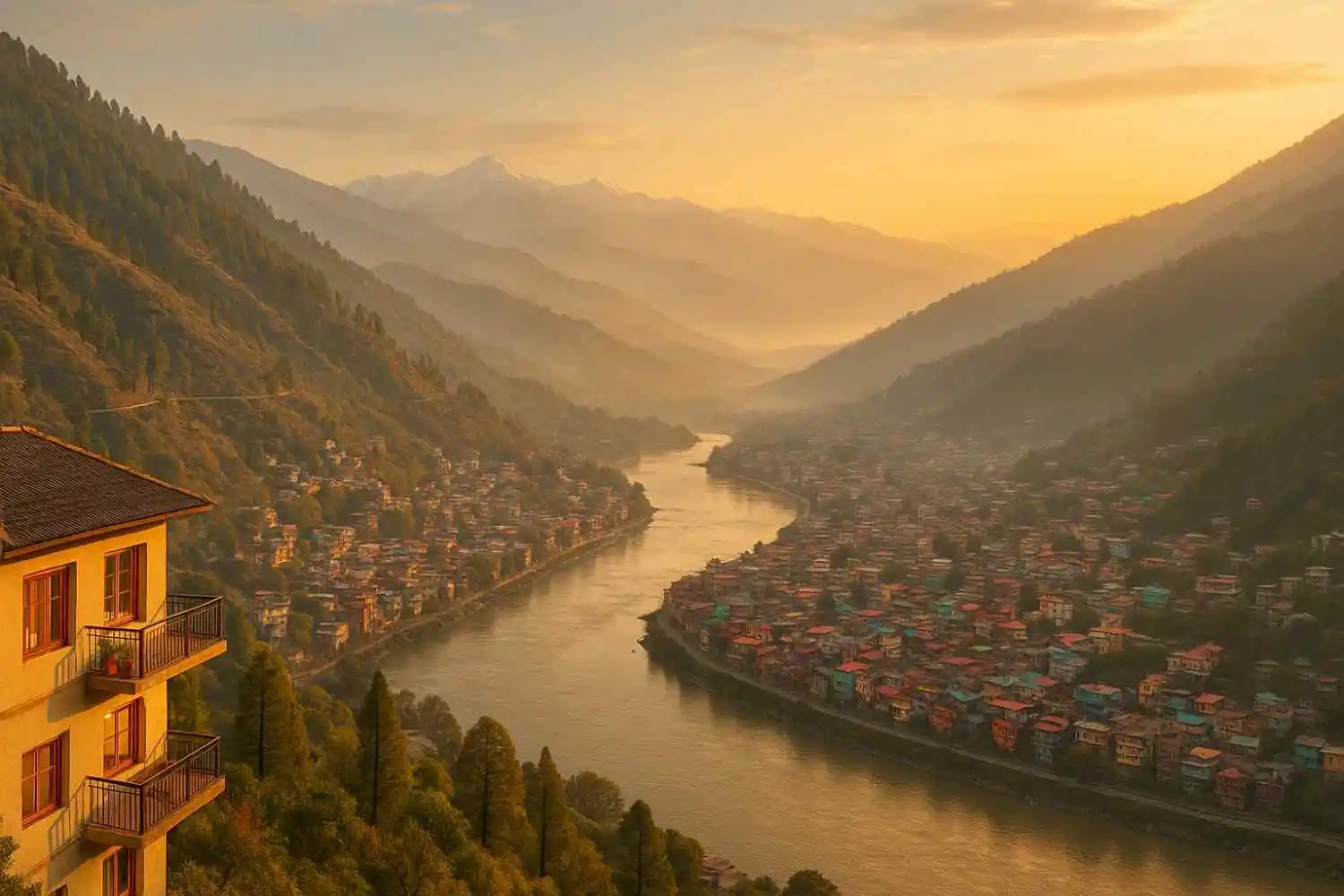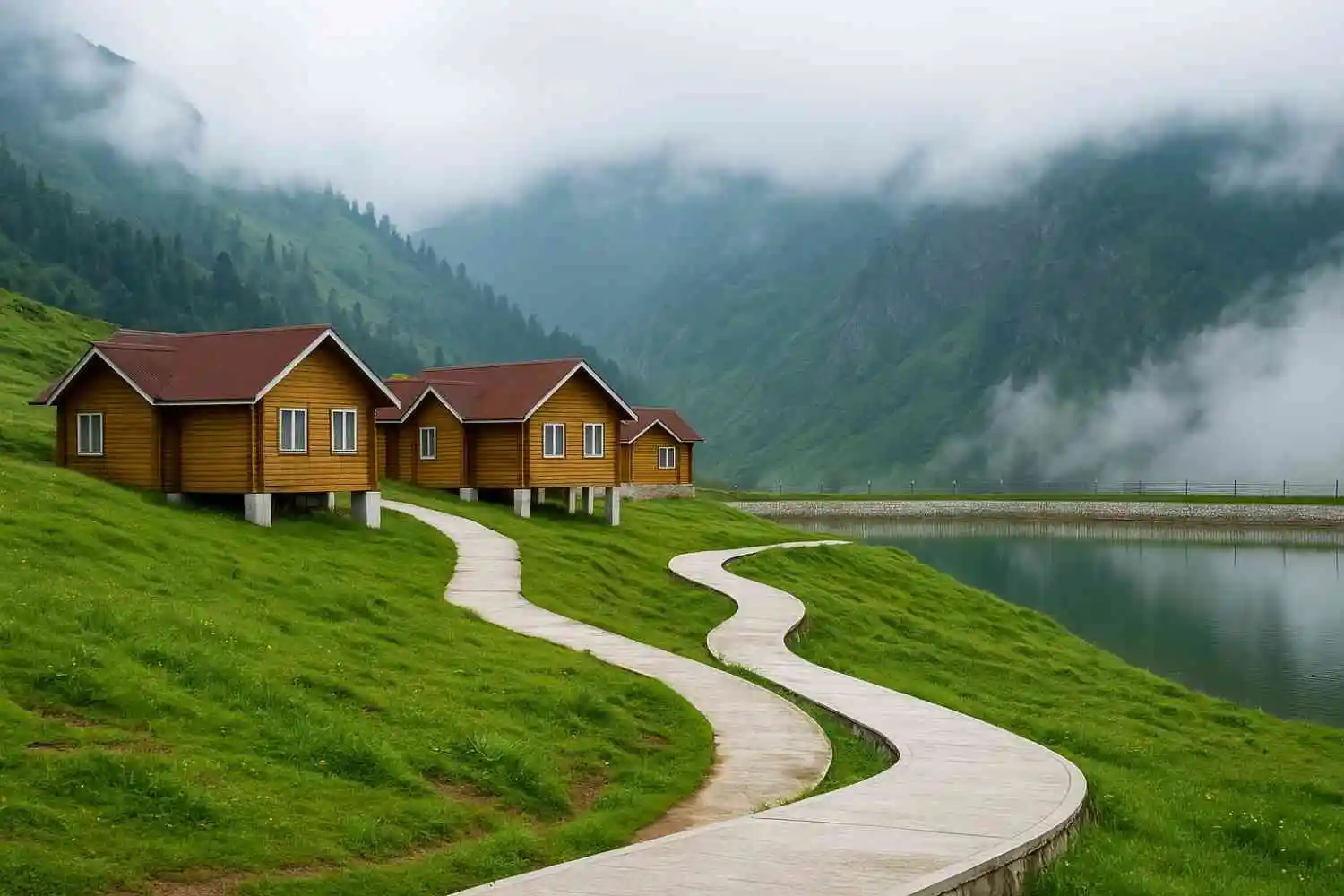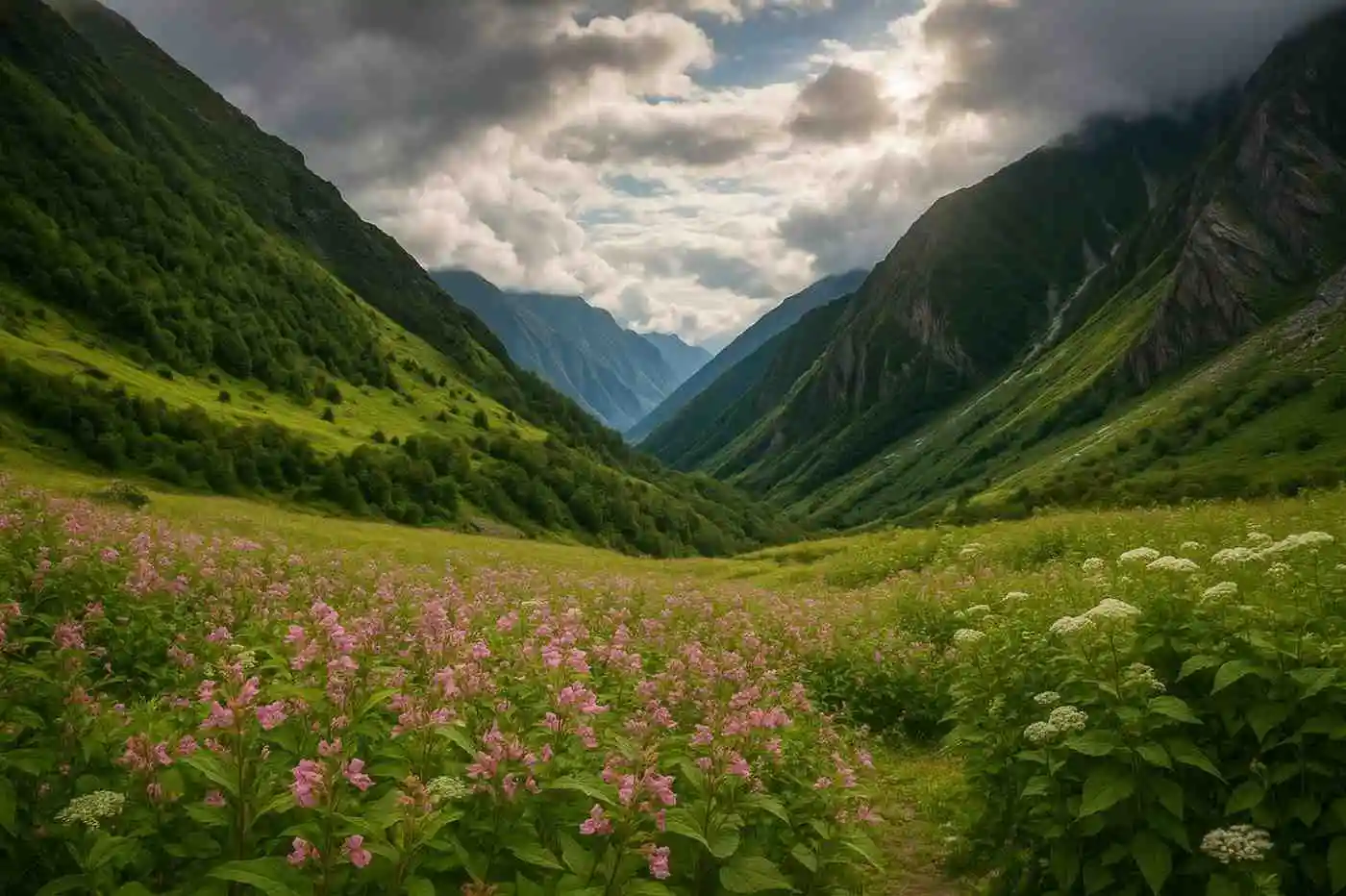If you’re planning Char Dham, sooner or later your compass points to Badrinath. The temple sits in a tight Himalayan bowl along the Alaknanda, fronted by the iconic Neelkanth peak. It’s where devotion, mountain weather, and age-old ritual all move in step. This guide keeps things practical: what Badrinath stands for, where it is, when the kapaat opens and closes, how to reach, darshan timings, places around town, where to stay, and the little tips that save you time and hassle.
About Badrinath Temple
1. What makes it one of the Char Dham
Badrinath is one of the four Himalayan dhams (with Yamunotri, Gangotri, and Kedarnath) and a major Vaishnavite shrine. The presiding deity is Lord Vishnu as Badrinarayan, worshipped in a black stone image seated in padmasana (meditative posture). The site’s stature comes from layered traditions: Adi Shankaracharya’s restoration in the early medieval period, Puranic references to tapasya of Nar–Narayan, and a constant thread of pilgrimage that has never really paused—only shifted with the seasons.
2. Importance of Lord Vishnu’s Badrinarayan form
Devotees see Badri Vishal as the compassionate preserver who grants refuge and clarity. The sanctum’s murti is associated with ancient meditation and penance in these valleys; for many, Badrinath marks the culmination of the entire Char Dham circuit.
3. Architectural highlights
Badrinath’s current structure blends Himalayan practicality with ornate detail. The complex is organized into the garbhagriha (sanctum), a darshan mandapa, and a sabha mandapa. The sanctum’s conical superstructure reaches roughly 15 m, capped by a gilded cupola; the façade has arched windows, and you climb a broad stairway through a tall gateway to enter. The stone halls carry intricate carvings and pillars that feel both intimate and ceremonial.
Badrinath Temple Location
1. Where it is situated
Badrinath lies in Chamoli district, Uttarakhand, in the upper Alaknanda valley of the Garhwal Himalayas. The temple town rests on the river’s right bank. Altitude and terrain give the place its distinctive, bracing air.
2. Height above sea level
The temple sits at about 3,133 m (10,279 ft)—high enough that mornings are cold even in May, and you’ll feel the altitude on brisk walks.
3. Surrounding peaks
To the east rises Neelkanth (often written Nilkanth), looming over town at 6,596 m; it backdrops countless dawn photos when the first light hits its face. Other ridges like Nar and Narayan Parbat flank the valley.
Badrinath Temple Opening & Closing Dates
1. Kapaat opening rituals
Badrinath opens in late April or early May, often on or near Akshaya Tritiya. The season begins with traditional rites that include the Akhanda Jyoti (the uninterrupted sacred flame) and Gadu Ghada, an oil-filled ceremonial pot representing Lakshmi’s blessing for the season’s worship. Each year, the exact day and hour are announced by the temple committee after astrological calculation and consultations. For 2025, for example, portals opened on May 4, 2025, with morning ceremonies.
2. Winter closure
The temple typically closes in late October or November (around Bhai Dooj). Rituals run for several days before closure, after which worship continues at winter seats. In Badrinath’s case, the Utsav Murti (festival idol) is taken to Narsingh Temple, Joshimath, for winter worship; associated deities and the Shankaracharya seat also shift as per custom. Media and Char Dham resources consistently document this move, sometimes also noting arrangements at Pandukeshwar (Yogadhyan Badri) for associated worship.
3. Best month for darshan
Crowds and weather shape this answer.
- May–June: Peak footfall; roads and services are fully active.
- September: Post-monsoon clarity and fewer crowds—arguably the sweet spot.
- Early October: Cold mornings, crisp views; nights get very chilly.
Month-by-month snapshot
| Month | Weather feel | Temple status | Travel advice |
| Late Apr | Very cold mornings; snow patches nearby | Opens for the season | Book stays early; carry heavy layers |
| May | Cold nights, sunny days | Open | Expect queues; start darshan early |
| Jun | Pleasant days, cool nights | Open | Afternoon clouds; keep rain shell |
| Jul | Wet, foggy, landslides possible | Open (weather-permitting) | Avoid unless necessary; monitor advisories |
| Aug | Similar to July | Open (weather-permitting) | Roadblocks likely during heavy rain |
| Sep | Clear, crisp | Open | Best balance of weather and crowd |
| Early Oct | Bright, cold | Open | Freezing nights; shorter daylight |
| Late Oct–Nov | Very cold; snowfall possible | Closing window | Check final darshan dates and traffic holds |
| Dec–Mar | Deep winter, snowbound | Closed (winter worship in Joshimath/Pandukeshwar) | Plan Winter Char Dham darshan at winter seats |
(Exact opening/closing dates are announced annually by the Badrinath-Kedarnath Temple Committee; check the season’s notice before you lock plans.)
History & Legends
1. Adi Shankaracharya
Tradition holds that Adi Shankaracharya rediscovered/established the shrine around the 8th–9th century, re-centering pilgrimage and rituals here. He’s credited with consolidating the Char Dham concept and reviving the Himalayan tirtha routes.
2. Tapasya of Nar–Narayan
The broader Badrikashram region is associated with austerities of the twin sages Nar and Narayan, incarnations of Vishnu engaged in penance here, giving the valley its deep Vaishnavite resonance.
3. Pandavas and Mahabharata
Garhwal lore places the Pandavas in these valleys on their final journey, visiting sacred spots around Badrinath. The landscape is dotted with place-names tied to those stories, reinforcing the idea that myth and mountain share the same map.
4. Significance of Tapt Kund
Just below the temple lies Tapt Kund, a naturally hot spring where pilgrims ritually bathe before darshan. Devotees associate the pool with Agni and with purification; many guides describe it as Vishnu’s own ritual bath before taking his Badrinarayan form. It’s hot even on cold mornings—dip cautiously.
How to Reach Badrinath Temple
You’ll almost always approach by road, with flight or rail only as far as the plains/foothills.
1. By Road
- From Rishikesh: roughly 286–300 km, 8–10 hours depending on season and traffic. The route follows the Ganga/Alaknanda valleys via Srinagar, Rudraprayag, and Joshimath.
- From Haridwar: commonly quoted around 300–320 km; add 30–60 minutes to Rishikesh timings.
- From Joshimath: ~44–46 km; plan 1.5–2 hours because of mountain bends, convoys, and occasional traffic holds.
- From Auli: ~56–60 km to Badrinath by road (Auli → Joshimath → Badrinath); about 1.5–3 hours depending on road condition and season.
Note on road safety: monsoon landslides and traffic controls between Pipalkoti–Joshimath–Badrinath are a reality; recent studies highlight high landslide susceptibility along the corridor, so keep your plan flexible.
2. By Flight
The nearest commercial airport is Jolly Grant (Dehradun). From there, it’s a road journey via Rishikesh–Srinagar–Rudraprayag–Joshimath to Badrinath.
3. By Train
Rishikesh and Haridwar are the usual railheads. Continue by bus, shared jeep, or taxi to Joshimath/Badrinath.
4. Helicopter Services (seasonal)
Heli operators run seasonal same-day or overnight Char Dham legs ex-Dehradun, and point-to-point services closer to the shrine season. Weather can delay or cancel flights; stick to authorized operators and beware fake websites advertising “instant heli tickets.” (Authorities have repeatedly cracked down on such scams.)
Badrinath Temple Timings & Aarti Schedule
Timings change slightly through the season, but official guidance provides a reliable frame:
- Morning: doors open early for Abhishek/Alankar and Darshan through the forenoon.
- Ved Path & Geeta Path continue after morning puja till bhog, then resume around 3:00 PM until evening aartis begin.
- Evening Aarti: typically around 6:00 PM to 8:30 PM in summer (excluding Shayan Aarti). Shayan Aarti has no fixed start; it begins after the day’s darshan queue is cleared.
1. Aarti and Puja tickets
Book Rudrabhishek, Vishnu Sahasranam path, Swarna/Kapoor Aarti, and other sevas via the temple’s official booking portal or counters. Slots, prices, and reporting times vary; arrive early with the same ID used for booking. Third-party “guaranteed VIP” claims should be treated with caution—always verify the source.
2. VIP Darshan
On some days, a limited special entry may run; it doesn’t override seasonal rush, weather, or VVIP movement. Keep buffer time.
Places to Visit Near Badrinath Temple
1. Mana Village (Tourism Village)
Just ~3 km upstream, Mana is branded as the “last Indian village” on this frontier sector. Expect stone houses, tea shops, and glimpses of the Saraswati river. It’s a lovely half-day with gentle walking.
2. Vasudhara Falls
A day hike beyond Mana (plan fitness and weather). The fall drops into a wide amphitheater—best post-monsoon when flows are strong.
3. Bheem Pul
A natural stone bridge over the Saraswati near Mana; a staple stop with good photo angles.
4. Charan Paduka
A steep trail from Badrinath to a rock said to bear the footprints of Vishnu—fine valley views.
5. Narad Kund
A pool near Tapt Kund is associated with the recovery of the Badrinarayan idol; devotees pause here before temple entry.
6. Brahma Kapal
A ghat on the Alaknanda used for shraddh rites; mornings are contemplative here with the river at your feet.
Where to Stay in Badrinath
1. Dharamshalas
Multiple trust-run lodges and dharamshalas operate near the temple. Expect basic rooms, shared bathrooms, and early quiet hours—simple, clean, and close to the action.
2. Mid-range hotels & lodges
Scattered across the main market approach. Many offer hot water (solar/geyser), blankets, and in-house dining geared to pilgrim routines.
3. GMVN accommodations
Garhwal Mandal Vikas Nigam runs tourist rest houses in the region (Badrinath/Joshimath/Auli) with dependable facilities and transparent pricing. These fill first during peak weeks.
4. Peak-season booking advice
- May–June and festival days get snapped up; book weeks ahead.
- Keep a Plan B at Joshimath in case of weather or traffic holds.
- Night temps drop hard—ask for extra blankets even if the room lists hot water.
Food & Prasad
1. Local Garhwali food
You’ll find simple thalis with dal, seasonal greens, aloo-based sabzis, hot rotis, and rice. On cold nights, a bowl of jhangora kheer or pahadi rajma hits the spot. In season, smaller cafés also serve parathas, poha, and tea through the morning rush.
2. Prasad
Temple-side shops sell dry prasad, laddoos, and offerings through the day. Morning hours see the quickest turnaround; evenings get busy before aarti. Check closing times on quieter weekdays so you don’t miss the counters.
Travel Tips for First-Time Visitors
1. Carry woolens & rain gear
Day can be sunny; the shade and evenings are icy. Pack a thermal base, fleece, padded/down jacket, beanie, gloves, and a rain shell even in May.
2. High-altitude precautions
At 3,100+ m, you’ll breathe harder on stairs. Pace yourself, keep sipping water, and avoid big meals right before steep walks. If you feel a headache or nausea, slow down and rest.
3. Cash and connectivity
ATMs exist, but are not guaranteed; networks wobble. Keep offline cash for taxis, dhabas, and small purchases.
4. Senior citizen help
Porters, wheelchairs, and short-distance assistance can be arranged via hotels or local facilitation desks. Consider breaking the road trip with a night in Joshimath to ease fatigue.
5. Medical support
A seasonal medical post and basic pharmacies operate; they carry regular meds, altitude-safe pain relief, and a personal first-aid kit.
6. Monsoon & safety
If you’re aiming for July–August, rethink it unless you must go. Landslides and road closures spike then. New studies have flagged parts of the Badrinath corridor as landslide-prone; plan with a margin.
7. Heli caution
Only use authorized heli-booking platforms or the operator’s official site; scams have been active around the Yatra season.
One-day and Two-day Sample Plans
If you’re short on time (ex-Joshimath):
- Early AM: Drive Joshimath → Badrinath (45–60 min).
- Morning: Tapt Kund, darshan, visit Brahma Kapal.
- Midday: Walk to Narad Kund and market lunch.
- Afternoon: Mana Village loop (Bheem Pul, short Saraswati walk).
- Evening: Return to Joshimath.
If you’ve got two nights:
- Day 1: Rishikesh/Haridwar → Joshimath (arrive early evening).
- Day 2: Joshimath → Badrinath (darshan, Mana, optional Charan Paduka). Stay at Badrinath or go back to Joshimath.
- Day 3: Auli ropeway in the morning; return to Rishikesh/Haridwar.
Darshan Flow: How to make it smooth
- Start early. Doors open before sunrise; the first two hours are calmer.
- Use official channels for puja/aarti bookings; print or save PDFs and carry the same ID used for booking.
- Dress in layers and wear shoes with grip; temple steps can be slick in drizzle.
- Pause at Tapt Kund for a cautious dip or splash; it’s a rite of passage before darshan, but test the temperature first.
- Stay flexible around monsoon and late-season weather.
Responsible Travel
Badrinath’s valley is spectacular and sensitive. Help keep it that way.
- Carry a reusable bottle and a trash pouch; pack out everything.
- Stick to marked paths; don’t clamber onto river boulders during high flow.
- Be respectful at shrines and kunds; keep soaps and shampoos out of sacred waters.
- During monsoon or after heavy rain, follow the traffic police/administration holds without argument—those controls are for your safety.
FAQs
It’s one of the Char Dham and the principal Himalayan shrine of Lord Vishnu as Badrinarayan, tied to Adi Shankaracharya’s revival and deep Vaishnavite traditions.
Typically late April or early May (around Akshaya Tritiya) with Vedic rites; it closes in late Oct/Nov before winter. Specific dates are announced each year by the temple committee—2025 opened on May 4.
Drive via Rishikesh–Srinagar–Rudraprayag–Joshimath; it’s ~286–300 km from Rishikesh and ~300–320 km from Haridwar depending on route and season. Buses, shared jeeps, and taxis run in season.
Expect cold mornings/evenings through the season: near-freezing at night in April/Oct, pleasant but cool in May–June, wet and chilly in monsoon, and snowbound in winter. (Carry layers year-round.)
Yes with sensible pacing—break the journey at Joshimath, keep warm, hydrate, and consider special-entry or assisted mobility. Avoid monsoon travel and very late-season nights if they’re sensitive to cold.
The high-altitude shrine is closed; winter worship continues at Narsingh Temple, Joshimath (Utsav Murti) and associated seats as per custom. Devotees visit the winter abodes instead.
Mana Village, Vasudhara Falls, Bheem Pul, Charan Paduka, Tapt Kund–Narad Kund, and Brahma Kapal are the popular set, all within easy reach of town.
For a comfortable pace: 3 days ex-Rishikesh/Haridwar (drive up with a night in Joshimath, Badrinath darshan + Mana, and drive back). Add another day if you want Vasudhara or Auli without rushing.






